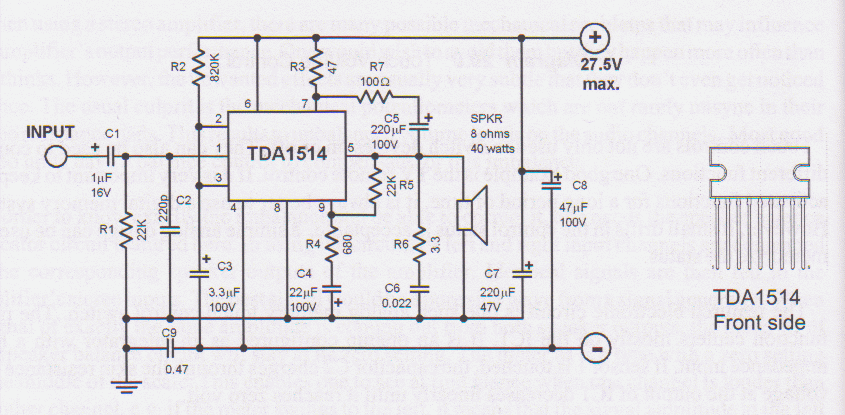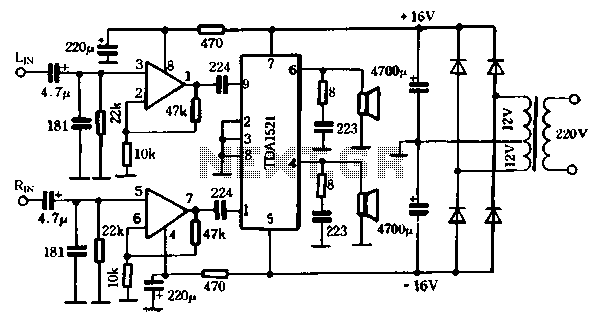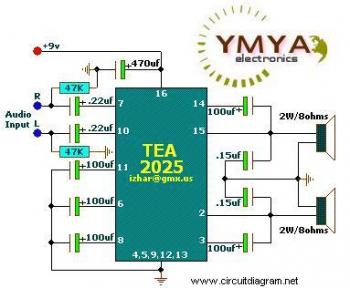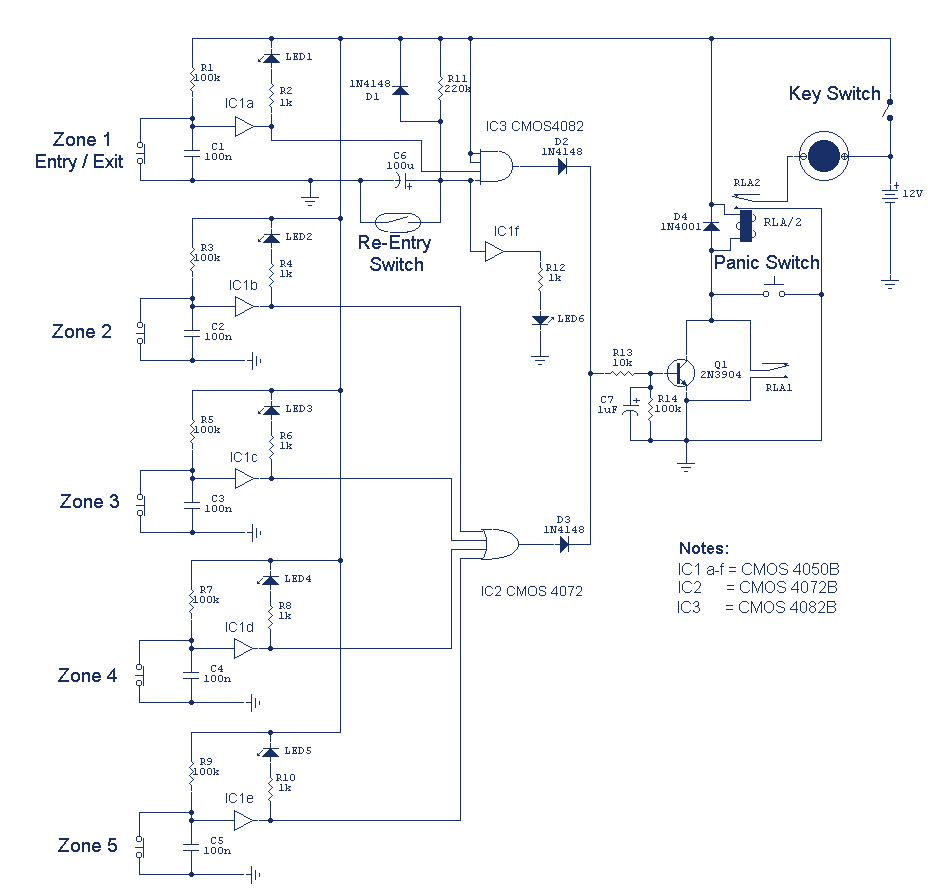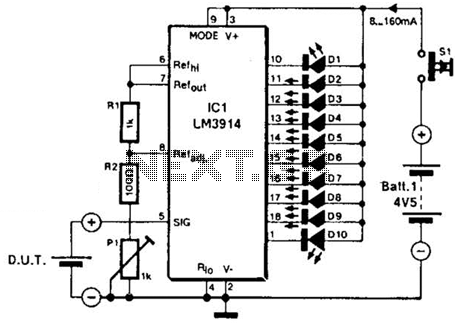
The driver alcohol detection alarm controller circuit diagram
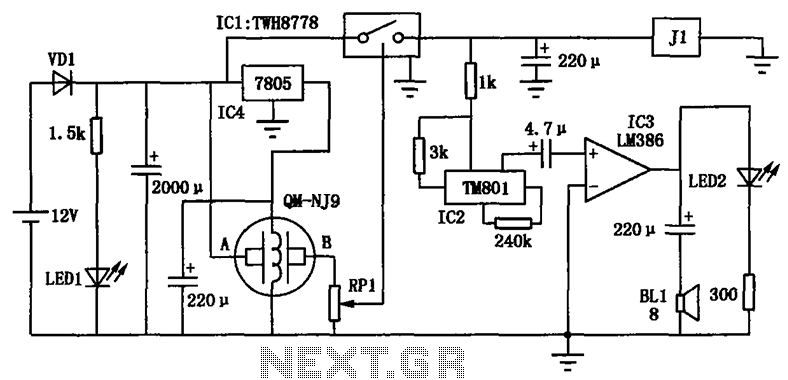
The alcohol detection alarm controller circuit is illustrated in the figure. It utilizes the QM-NJ9 alcohol gas sensor, which detects the presence of alcohol vapors. When alcohol is detected, the resistance between the AB-QM-NJ9 decreases, causing the wiper of the potentiometer RPl to increase. When the voltage rises to 1.6V, the power switching device ICl (TWH8778) is activated. This, in turn, triggers IC2 (TM801) to produce sound through the integrated amplifier IC3 (LM386), which drives the power amplifier speaker BLl to emit an alarm. Simultaneously, relay J1 is energized, opening its break contact to cut off the vehicle's ignition circuit, effectively stalling the engine to prevent drunken driving.
The alcohol detection alarm controller circuit operates as a safety mechanism to prevent driving under the influence. The QM-NJ9 sensor is sensitive to alcohol vapors, providing an essential first line of detection. When alcohol is present, it reduces the resistance in the circuit, which is a critical parameter for the operation of the wiper potentiometer RPl. As the resistance decreases, the voltage at the wiper increases, and once it reaches the predetermined threshold of 1.6V, it activates the TWH8778 power switching device.
The TWH8778 is designed to manage high currents and voltages, allowing it to effectively control the subsequent components in the circuit. The activation of the TM801 integrated circuit generates an audible alarm through the LM386 amplifier, which is a low-voltage audio amplifier capable of delivering sufficient power to drive the BL1 speaker. This audible signal serves as a warning to the driver and surrounding individuals.
In conjunction with the alarm, the relay J1 plays a crucial role in the overall functionality of the system. When energized, it interrupts the vehicle's ignition circuit by opening its break contact. This action prevents the engine from running, thereby stopping the vehicle and mitigating the risk of an accident due to impaired driving. The design of this circuit emphasizes safety and responsiveness, making it an effective tool for enhancing road safety by deterring individuals from driving while intoxicated. The integration of sensor technology with alarm and relay systems exemplifies a practical application of electronics in public safety initiatives. As shown in FIG alcohol detection alarm controller circuit. QM-NJ9 for alcohol gas sensors, if detected the odor of alcohol, the AB-QM-NJ9 between resistance becomes smaller, t he wiper potentiometer potentiometer RPl increases. When the potential rise to l.6V, ICl TWH8778 power switching device is turned on, the IC2 IC TM801 voice work, which outputs the integrated amplifier IC3 LM386 were pushing the power amplifier speaker BLl alarm. At the same time, the relay J1 was electric action, its break contact off, cut off vehicle ignition circuit, forcing the engine stall, the driver to control drunken driving purposes.
The alcohol detection alarm controller circuit operates as a safety mechanism to prevent driving under the influence. The QM-NJ9 sensor is sensitive to alcohol vapors, providing an essential first line of detection. When alcohol is present, it reduces the resistance in the circuit, which is a critical parameter for the operation of the wiper potentiometer RPl. As the resistance decreases, the voltage at the wiper increases, and once it reaches the predetermined threshold of 1.6V, it activates the TWH8778 power switching device.
The TWH8778 is designed to manage high currents and voltages, allowing it to effectively control the subsequent components in the circuit. The activation of the TM801 integrated circuit generates an audible alarm through the LM386 amplifier, which is a low-voltage audio amplifier capable of delivering sufficient power to drive the BL1 speaker. This audible signal serves as a warning to the driver and surrounding individuals.
In conjunction with the alarm, the relay J1 plays a crucial role in the overall functionality of the system. When energized, it interrupts the vehicle's ignition circuit by opening its break contact. This action prevents the engine from running, thereby stopping the vehicle and mitigating the risk of an accident due to impaired driving. The design of this circuit emphasizes safety and responsiveness, making it an effective tool for enhancing road safety by deterring individuals from driving while intoxicated. The integration of sensor technology with alarm and relay systems exemplifies a practical application of electronics in public safety initiatives. As shown in FIG alcohol detection alarm controller circuit. QM-NJ9 for alcohol gas sensors, if detected the odor of alcohol, the AB-QM-NJ9 between resistance becomes smaller, t he wiper potentiometer potentiometer RPl increases. When the potential rise to l.6V, ICl TWH8778 power switching device is turned on, the IC2 IC TM801 voice work, which outputs the integrated amplifier IC3 LM386 were pushing the power amplifier speaker BLl alarm. At the same time, the relay J1 was electric action, its break contact off, cut off vehicle ignition circuit, forcing the engine stall, the driver to control drunken driving purposes.
Warning: include(partials/cookie-banner.php): Failed to open stream: Permission denied in /var/www/html/nextgr/view-circuit.php on line 713
Warning: include(): Failed opening 'partials/cookie-banner.php' for inclusion (include_path='.:/usr/share/php') in /var/www/html/nextgr/view-circuit.php on line 713
